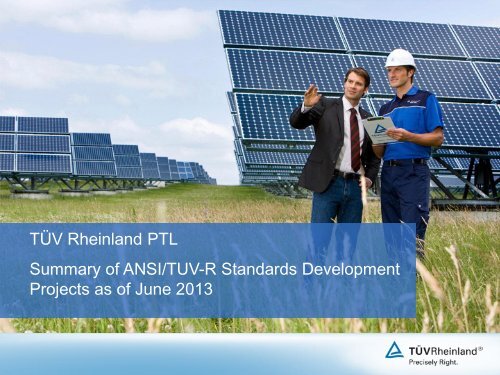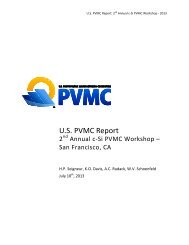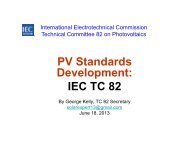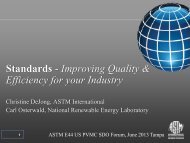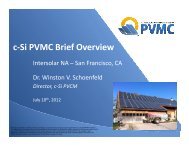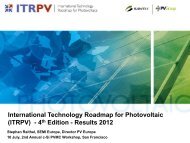TUV-PTL ANSI Overview.pdf - PVMC
TUV-PTL ANSI Overview.pdf - PVMC
TUV-PTL ANSI Overview.pdf - PVMC
Create successful ePaper yourself
Turn your PDF publications into a flip-book with our unique Google optimized e-Paper software.
TÜV Rheinland <strong>PTL</strong>Summary of <strong>ANSI</strong>/<strong>TUV</strong>-R Standards DevelopmentProjects as of June 2013
<strong>TUV</strong> Rheinland: Worldwide Solar PV TestingSolar PV testing: 7 locations worldwide ….• Tempe/Arizona, USA• Cologne, Germany• Shanghai, China• Yokohama, Japan• Taichung, Taiwan• Bangalore, India• Gyeongsan, KoreaProfoundly contributing to national, regional and international standards developments.2
<strong>TUV</strong> Rheinland <strong>PTL</strong>: NRTL and SDOBecame an….• NRTL: 2011 (OSHA accreditation for solar PV testing and certification)• SDO: 2012 (<strong>ANSI</strong> accreditation for developing standards including solar PV)3
Standard Designation/Numbering SystemStandards<strong>TUV</strong>-R 7xxyy-01Numbering/Designation for Solar PV: Examplexx = 17 (Module), 18 (BOS) or 19 (System)yy = standard number01 = part numberThis numbering system is subject to change.4
<strong>ANSI</strong>/<strong>TUV</strong>-R Standards Under Development‣ <strong>TUV</strong>-R 71730-01: Photovoltaic (PV) Modules Under the Effects ofInhomogeneous Snow Loads – Design Qualification and Type Approval.‣ <strong>TUV</strong>-R 71830-01: Microinverters and Microconverters – DesignQualification and Type Approval.‣ <strong>TUV</strong>-R 71930-01: Integration and Construction Requirements of PowerConversion Stations for Utility-Scale Renewable Energy Power Plants.5
<strong>TUV</strong>-R 71730-01: Inhomogeneous Snow LoadsSCOPE:<strong>TUV</strong>-R 71730-01 describes requirements for the design qualification and typeapproval of PV modules under the effects of inhomogeneous snow loads suitable forlong-term operation in climates where snow is prevalent. These specificationsdescribe a test method for determining the direct load-bearing capability of PVmodules under these snow conditions.6
<strong>TUV</strong>-R 71730-01: Inhomogeneous Snow LoadsNEED:‣ IEC 61215/61646: Horizontal, uniform snow load test (5400 Pa)‣ Supplement to the IEC 61215/61646 snow load test‣ Field experience in installing and using PV modules had revealed damagefrom inhomogeneous snow load displacements at the typical tilt anglesbetween 30° and 45°7
<strong>TUV</strong>-R 71730-01: Inhomogeneous Snow LoadsPotential References:NFPA 70IEC 61215IEC 61646IEC 61730-2National Electrical CodeCrystalline silicon terrestrial photovoltaic (PV) modules – Designqualification and type approvalThin-film terrestrial photovoltaic (PV) modules – Design qualificationand type approvalPhotovoltaic (PV) module safety qualification – Part 2: Requirementsfor testingEN 1991-1-3:2010-12 Eurocode 1: Actions on structures – Parts 1-3: General actions –Snow loadsEN 1990:2002-12Eurocode 0: Basis of structural design2 PfG 2310 Test for Qualifying Photovoltaic (PV) Modules under the Effects ofInhomogeneous Snow Loads.8
<strong>TUV</strong>-R 71730-01: Inhomogeneous Snow LoadsTentative Timeline:‣ PINS Submitted to <strong>ANSI</strong> 3/25/2013‣ Published in <strong>ANSI</strong> Standards Action 3/29/2013‣ Receive Responses to PINS 4/29/2013‣ Solicit Working Group Members 3/29/2013 to Open‣ Develop Working Draft Standard 1/15/2014‣ Develop Draft Proposed Standard 8/28/2014‣ Public Review of Proposed Standard 10/20/2014‣ Comment Resolution 12/15/2015‣ Recirculation if Applicable 1/15/2015‣ Appeals at the Developer Level if Applicable 2/30/2015‣ Submit to <strong>ANSI</strong> for Approval 3/5/2015‣ Notification of Approval / Disapproval from <strong>ANSI</strong> 4/15/2015‣ Appeal at <strong>ANSI</strong> if Applicable 6/2/2015* Timeline subject to adjustments as process unfolds.9
<strong>TUV</strong>-R 71830-01: Microinverters and MicroconvertersSCOPE:<strong>TUV</strong>-R 71830 describes the design qualification and type approval requirementsfor microinverters and microconverters for long-term operation in general openair climates. The standard aims to determine minimum requirements for qualityand reliability of the microinverters and microconverters and to show that theyare capable of withstanding prolonged exposure in open air climates.10
<strong>TUV</strong>-R 71830-01: Microinverters and MicroconvertersNEED:‣ Qualification standards for modules exist‣ Qualification standards for module level power conditioners do not exist‣ Module level power conversion devices undergo higher level environmentalstresses as compared to central/string inverters (hotter environment on theback of the module!)‣ Sample size and stress tests may have to be different as compared to stringand central inverters11
<strong>TUV</strong>-R 71830-01: Microinverters and MicroconvertersPotential References:ECN-C-04-032IEC 60529IEC 61683IEC 61727IEC 61836IEC 62093IEC 62124NFPA 70UL 17412PfG 2305IPC 9592ADesign qualification of inverters for grid-connected operation ofphotovoltaic power generatorsDegrees of protection provided by enclosures (IP Code)Photovoltaic systems - Power conditioners - Procedure for measuringefficiencyPhotovoltaic (PV) systems - Characteristics of the utility interfaceSolar photovoltaic energy systems - Terms, definitions and symbolsBalance-of-system components for photovoltaic systems - Designqualification natural environmentsPhotovoltaic (PV) stand alone systems - Design verificationNational Electrical CodeStandard for Inverters, Converters, Controllers and InterconnectionSystems for use with Distributed Energy ResourcesTest program for junction boxes with active electronicsRequirements for Power Conversion Devices for the Computer andTelecommunications Industries12
<strong>TUV</strong>-R 71830-01: Microinverters and MicroconvertersTentative Timeline:‣ PINS Submitted to <strong>ANSI</strong> 3/19/2013‣ Published in <strong>ANSI</strong> Standards Action 3/29/2013‣ Receive Responses to PINS 4/29/2013‣ Solicit Working Group Members 3/29/2013 to 10/30/2013‣ Develop Working Draft Standard 1/20/2014‣ Develop Draft Proposed Standard 10/25/2014‣ Public Review of Proposed Standard 12/20/2014‣ Comment Resolution 2/15/2015‣ Recirculation if Applicable 3/15/2015‣ Appeals at the Developer Level if Applicable 4/30/2015‣ Submit to <strong>ANSI</strong> for Approval 5/5/2015‣ Notification of Approval / Disapproval from <strong>ANSI</strong> 6/15/2015‣ Appeal at <strong>ANSI</strong> if Applicable 8/2/2015* Timeline subject to adjustments as process unfolds.13
<strong>TUV</strong>-R 71930-01: Power Conversion StationsSCOPE:<strong>TUV</strong>-R 71930 describes safety and general requirements for assemblies ofpower conversion systems for utility-scale renewable energy power plants (REPCS). The standard defines the minimum requirements for the design andfabrication of RE PCS for protection against electrical, fire, mechanical andother hazards. The products covered by these requirements are intended to beinstalled in accordance with NFPA 70: National Electrical Code®.14
<strong>TUV</strong>-R 71930-01: Power Conversion Stations1 Scope and Objective1.1 These requirements cover Power Conversion Stations intended for installation atPhotovoltaic (PV) Power Plants greater than 10 MW. This equipment is intended foroperation circuits at a voltage of 1500 volts or less.1.2 A Power Conversion Station is a pre-assembly of equipment that may include, but notlimited to:1.2.1 Container, Shelter and/or Sub-structure1.2.2 Inverter or Combination of Inverters1.2.3 DC Combiner Panel1.2.4 HVAC or Ventilation Fans1.2.5 Ventilation Control Panel1.2.6 Data Acquisition Panel1.2.7 Supervisory Control Panel15
<strong>TUV</strong>-R 71930-01Potential References:NFPA 70UL 486A-486BUL 508AUL 508CUL 1741UL 61010-1National Electrical CodeWire ConnectorsIndustrial Control PanelsStandard for Power Control EquipmentStandard for Inverters, Converters, Controllers and InterconnectionSystems for use with Distributed Energy ResourcesElectrical Equipment for Measurement, Control, and Laboratory Use; Part1: General Requirements16
<strong>TUV</strong>-R 71930-01Tentative Timeline:‣ PINS Submitted to <strong>ANSI</strong> 1/28/2013‣ Published in <strong>ANSI</strong> Standards Action 2/8/2013‣ Receive Responses to PINS 3/8/2013‣ Solicit Working Group Members 2/8/2013 to 10/30/2013‣ Develop Working Draft Standard 1/28/2014‣ Develop Draft Proposed Standard 9/28/2014‣ Public Review of Proposed Standard 11/20/2014‣ Comment Resolution 1/15/2015‣ Recirculation if Applicable 2/15/2015‣ Appeals at the Developer Level if Applicable 3/30/2015‣ Submit to <strong>ANSI</strong> for Approval 4/5/2015‣ Notification of Approval / Disapproval from <strong>ANSI</strong> 5/15/2015‣ Appeal at <strong>ANSI</strong> if Applicable 7/2/2015* Timeline subject to adjustments as process unfolds.17
<strong>TUV</strong>-R Standards: Applying for MembershipCurrent Working Group Member Companies:Burns & McDonnell, CanadianSolar, Celestica, DNV KEMA Renewables, EnphaseEnergy, First Solar, FM Approvals, NY Solar Energy Society, Power-One,SolarBridge Technologies, SolarEdge, Sunset Technology, TÜV Rheinland,Varentec, Zep Solar……and growing!Apply for membership on any or all working groups:http://education.tuv.com/solar-ansi-advisoryOrContact: Jerome Novacek, JNovacek@tuvptl.com18


